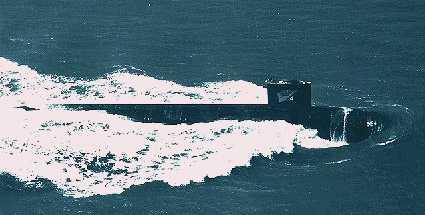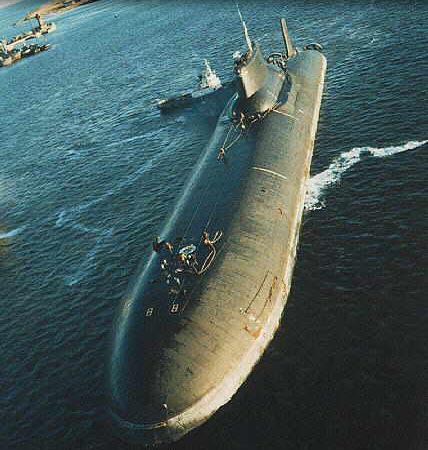10 - USS Tullibee (SSN-597)
Smaller than other nuclear-powered attack submarines, the USS Tullibee proved no less important to the United States Navy during the Cold War.
USS Tullibee (SSN-597), then a "state-of-the-art" construction of the early 1960s, and was the smallest nuclear-powered attack submarine class ever built for the United States Navy (USN) - making her one of the more unique implements of that branch. The Tullibee contract was awarded to the Electric Boat Division of the General Dynamics Corporation in November 1957 and she was commissioned on November 9th, 1960.
Design-wise, Tullibee was 273 feet long and maintained a surface displacement of 2,300 tons. In comparison, other like-minded nuclear subs such as the Nautilus - the first nuclear submarine - was 320 feet long and displaced at 3,520 tons. Similarly, the newest modern submarine class - the USS Virginia - is 377 feet and 7,900 tons displaced. SSN-577s small size required a similarly sized crew complement ranging between 7 officers and 60 enlisted men to 13 officers and over 100 enlisted sailors. The name,Tullibee itself came from a French word for the freshwater whitefish of central and northern North America. The ship was classified as a "Hunter-Killer", her primary mission being that of detecting, engaging and destroying enemy submarines in her path.
The Tullibee was a class of submarine developed as a test platform for new technology. "Project Nobska" was the research program ordered in 1956 by Chief of Naval Operations, Admiral Arleigh Burke. The resulting report from the Committee on Undersea Warfare concluded that current USN technology for hunter-killer submarines required substantial improvements in order to effectively fulfill their missions. Boats needed to have the hull capacity to dive deeper and to rely on stealth so it became imperative that new technology be developed to improve on new "ultra-quiet" designs. Equally as important was the need to develop and improve the tactics needed to get the most out of the new long range sonar - giving USN hunter-killers the ability to "see" the enemy first and furthermore kill him before he could let loose a shot.
Based on the conclusions from Project Nobska, Tullibee was provided with new design system upgrades for testing for possible use in future submarines. Currently in use on most US Navy nuclear submarines was the S5W reactor, an electric drive system. The new reactor developed for SSN-597 was the S2C prototype built in Windsor Locks, Connecticut. The S2C was an advanced design and similar to the S5W but smaller in size and developed to be a very quite system. The major difference in the new S2C design was its power coming from two steam turbines driving a turboelectric powerplant. The S5W turbines drove a series of reduction gears that were not as quiet under water. Another suggested design change was to produce and test the prototype AN/BQQ Sonar System, this a bow-mounted spherical sonar array - the first of its kind. This new, long-reaching sonar system took up most of the bow of the submarine's internals and proved a breakthrough design that spurred along another new development - angled torpedo tubes held amidships along the port and starboard sides of the hull.
The all-important "shakedown" cruise for the Tullibee started in mid-January of 1961 and included all of the normal testing such as diving and surfacing the boat, checking for those all-important leaks plus reviewing all major and minor system operations such as the kitchen's dish washer (with all seriousness). With all systems checking out correctly, Tullibee was assigned to Submarine Developmental Group 2 for further testing surrounding her new prototype systems. She tested her sonar and her crew was drilled on nuclear submarine tactical exercises using all her new systems. These tests were completed in and around the waters of Puerto Rico as well as Bermuda and visited the islands during her ports of call. Into late 1963, SSN-597 continued her testing and operated out of the Naval Submarine Base in New London, Connecticut.
While performing her scheduled duties,Tullibee also participated in fleet exercises in anti-submarine warfare (ASW) tactics with NATO elements until 1965. In October of that year, she was assigned to Portsmouth Naval Shipyard in Kittery, Maine, for a major overhaul. This refit was for multiple reasons: first, the required normal review of all her systems and subsystems and, second, she needed some changes on her prototype AN/BQQ sonar system and the S2C reactor. This refit was completed in dry dock and took some 754 days. With everything being found correct, she was returned to active duty on January 2nd, 1968. Now with a new crew she began training so her new sailors could become accustom to the nuances of the little-yet-mighty USS Tullibee.
Once again, her port was New London where she continued her mission to train on and test her prototype systems. She continued system analysis testing in the Caribbean waters up until mid-1970. USS Tullibee then departed New London and sailed for the Sixth Fleet in the Mediterranean - her first fleet assignment - and during this time, she was no longer a test platform but a full-fledged attack submarine.
SSN-597 took part in Sixth Fleet exercises that included NATO forces and made port visits with the fleet to Spain, Italy, and Greece. In early December she was reassigned to New London. Before her return, she had covered some 20,000 nautical miles (30,000 kilometers) in 135 days while averaging a speed of 6 nautical miles per hour. For fulfilling her mission requirements covering September 9th, to October 31st,1970 in the Mediterranean Sea, Tullibee received the Meritorious Unit Commendation.
In early 1971, Tulliee returned to training exercises once more and worked on furthering hunter-killer tactics. She participated in another NATO exercise that year until December and was awarded the Arleigh Burke Fleet Trophy for high improvement in the ship's battle efficiency readiness status. This efficiency trophy required the crew to dive and go to full-ready battle stations within a specified period of time. Additionally, reports on sonar readiness played an important role in achieving the award.
She continued to patrol in the Caribbean Sea until the Spring of 1975 to which she then departed New London for her second deployment with the Sixth Fleet. Tulliee continued to conduct ASW operations until the fall of 1976. The mission was interrupted when a propulsion problem required a two-month dock repair at Rota, Spain. When the reactor issue had been resolved, Tullibee returned to New London and operated out of her home port into 1979. In July of 1979, she once again needed an overhaul that turned out to be of longer duration than initially anticipated, totaling some 39 months. Her crew was reassigned while their boat was in the yard.
Upon completion of the refit she was re-crewed and training for the new personnel ensued for the remainder of 1982. Another setback occurred with the propulsion system in 1983 and forced the boat to return once more to the New London yard. In 1985, she was deployed for the last time and joined the Sixth Fleet to take part in additional ASW exercises. This was her new crews first deployment and the mission assigned to the Tullibee was completed with no issue. For outstanding mission compliance, the Tullibee was awarded the Navy Expeditionary Medal along with her first Navy Unit Commendation.
Essentially, the SSN-597 was designed as a test ship and helped to further USN development of ultra-quite reactor systems while helping to develop the all-important long-reaching sonar for today's ASW boats. She was a credit to the United States Navy as were her crews.
The ship was assigned to pier side in New London in September of 1987. USS Tullibee (SSN-597) was then towed to Portsmouth Naval Shipyard to begin a ten month inactivation and decommissioning period. The Tullibee was officially stricken from the Naval Vessel Register on June 25th, 1988, and entered the Navy's Nuclear Powered Ship and Submarine Recycling Program in January 1995. The submarines reactor was removed and recycled along with as many useful parts as possible.




















